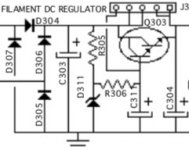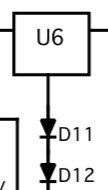Good hint, or maybe simply a cell more ? than we can even eat 11-12V...maybe I will ask Ian what his experience is and maybe one of his little boards can be modified...
I think the guys swear on them because of low ESR and low noise...they are seen as an improvement/added feature to Li-Ion battery supplies.
I think the guys swear on them because of low ESR and low noise...they are seen as an improvement/added feature to Li-Ion battery supplies.
The lifetime goes down quickly at too high voltages, but so far I haven't had any explosions, venting electrolytes or other malfunctions when 2.7 V cells were unintendedly subjected to 3 V for a very short time. Still, it's better to be safe than sorry, and operating them at a lower than rated voltage will improve their lifetime substantially.
A simple capacitor multiplier will give you noise free DC. If it follows a regulator it's stable quiet DC.
+1
It could be more efficient to use a rectifier and rather extreme smoothing with supercapacitors instead of a rectifier, some smoothing with electrolytic capacitors and a series regulator. One has to be careful not to overheat the transformer during charging, though - at power-on, the capacitor will effectively short the rectifier output and it can take minutes before it reaches the intended voltage. When you insert a resistor to limit the charging current, you probably lose the efficiency advantage over a series regulator, if any.
I don't think super capacitors would like having constant ripple current. If you're worried about noise then parallel some LT3045 regulators. LT3045 Datasheet and Product Info | Analog Devices
I will test them at some point of time using a resistor for the first 5min when heating up and tgan have a switch or time delay taking the resistor out... jt will be LCRC supply, so ripple current will be low. I just figured that DHT are extremely sensitive soundwise. You hear anything you do there. Cap types choke types, regulators. Each has its own signature...as they are somewhat in the signal path I guess. But its stunning. So no idea, if supercaps will sound good or bad, need to try.
I don't think super capacitors would like having constant ripple current.
I think it should be OK when you manage to keep the self-heating limited.
Although the datasheet of the model Blitz chose ( https://www.mouser.de/datasheet/2/257/CE_2017_Datasheet_2_7V325F_3001962_EN_1-1274163.pdf ) specifies a maximum of 500 000 cycles from 50 % to 100 % charge and back (which is of course much deeper than the charging and discharging you would get from mains ripple), according to CAP-XX, CAP-XX Supercapacitors Product Guide, version 6.2, January 2019, "Voltage cycling at low RMS current will not affect life. Cycling at high RMS current will cause self-heating, which will increase ageing rates."
Assuming that's true, the ripple current just has to be small enough. A current of 30 A causes 15 K of self-heating, which already affects the lifetime substantially, but 15 A RMS ripple (3.75 K self-heating) should be no problem.
Yes, I would maybe go into it with max 30mV, max 100mV restripple. That is the beauty of choke input power supply. 30mV is for normal conditions a bit too high, you will hear humm. The super cap therefore really acts as a battery like buffer, it brings the rest ripple under a fraction of a mV etc. Esr low etc...but still this does not mean it sounds good...need to try...but thanks for the guidance, just did not wanted to blow stuff up
Filament regulation possibilities
Jeez. While all these design points are valid I think everyone is overthinking this.
Use Schottky rectifiers - 1N5821 in bridge, low loss diode drops followed by an 18K mfd cap. You will have sawtooth ripple but much lower than 6.3 ac.
If still hum, you can use a capacitor multiplier or zener based circuit for filtering. Leave the zener out for a cap multiplier. You'll have about a millivolt of ripple. If that causes a problem you may have defective tubes. I just did one for a client and used a TIP120 darlington TO220 transistor chassis mounted. Dead nuts quiet.
You can also use a LM2940CT-5.0 low drop out regulator. 5 volts but on top of 2 1N4007s it's 6.3 volts as shown in the 2nd pix.
If you are using an ancient power transformer and are leery of it overheating then buy a toroid 7 VAC 35 watt transformer to take the load off the main PT.
Here's what I used in the Moscode 400 series amplifiers for the 2 input tubes up to 2 amps current. 1st photo Passive regulation. Good enough for filaments and very quiet, in fact quiet enough to hunt wabbits.
Jeez. While all these design points are valid I think everyone is overthinking this.
Use Schottky rectifiers - 1N5821 in bridge, low loss diode drops followed by an 18K mfd cap. You will have sawtooth ripple but much lower than 6.3 ac.
If still hum, you can use a capacitor multiplier or zener based circuit for filtering. Leave the zener out for a cap multiplier. You'll have about a millivolt of ripple. If that causes a problem you may have defective tubes. I just did one for a client and used a TIP120 darlington TO220 transistor chassis mounted. Dead nuts quiet.
You can also use a LM2940CT-5.0 low drop out regulator. 5 volts but on top of 2 1N4007s it's 6.3 volts as shown in the 2nd pix.
If you are using an ancient power transformer and are leery of it overheating then buy a toroid 7 VAC 35 watt transformer to take the load off the main PT.
Here's what I used in the Moscode 400 series amplifiers for the 2 input tubes up to 2 amps current. 1st photo Passive regulation. Good enough for filaments and very quiet, in fact quiet enough to hunt wabbits.
Attachments
I have the coleman regs in all variatons here as well...and use Lt4320 ideal bridges as raw supply...what I figured is, you hear anything on the cathode...and it is not predictable which fits to your overall setup, sooo, I am just figuring out what does what...and than to do my choice
Here's what I used in the Moscode 400 series amplifiers for the 2 input tubes up to 2 amps current. 1st photo Passive regulation. Good enough for filaments and very quiet, in fact quiet enough to hunt wabbits.
No filaments in the Moscodes, right? Apples and oranges. And no one is trying to fight hum here.
Have you built anything with filaments? Have you compared AC vs DC vs current sourced filament supplies? Used Coleman's regulators? Observed the audible effects of different chokes in the raw dc supplies? Different caps?
Clearly, I use fixed bias and no autobias cathode stuff ....brrrr....
No, i enjoyed Rod coleman Regs now for many years all over the place. I became curious to do a bit more research when I started to compare Rods V7 vs. v8...which have an audible difference. Than I got great support from Rod to play with some caps and components of the reg etcetc....basically you hear everything what you do at the cathode....and humm is not there, even with my raw supply without regs its gone already.
Latest discovery was the differential use of chokes which give a very stiff presentation, like a kind of reg introduced, maybe more resolution, but less warmer tone...but it does something.
No, i enjoyed Rod coleman Regs now for many years all over the place. I became curious to do a bit more research when I started to compare Rods V7 vs. v8...which have an audible difference. Than I got great support from Rod to play with some caps and components of the reg etcetc....basically you hear everything what you do at the cathode....and humm is not there, even with my raw supply without regs its gone already.
Latest discovery was the differential use of chokes which give a very stiff presentation, like a kind of reg introduced, maybe more resolution, but less warmer tone...but it does something.
Last edited:
No filaments in the Moscodes, right? Apples and oranges. And no one is trying to fight hum here.
Have you built anything with filaments? Have you compared AC vs DC vs current sourced filament supplies? Used Coleman's regulators? Observed the audible effects of different chokes in the raw dc supplies? Different caps?
Yes, Yes, Yes, No, Yes, Yes, Yes. What's a Coleman's Regulator? Do I take it camping?
All Moscode products are a combination of tubes and solid state and were introduced in 1984 at the HIFI show in Chicago.
Amplifiers use 4 to 7 tubes, transistors and lateral mosfets.
Phono preamp uses 3 tubes, and is dead quiet.
Minuet and Minuet in A preamps use 4.
You can look it up
I was lighting up filaments with a train transformer in my Dad's HAM shack at the age of 5 in 1955. This was before there was a CK722 germanium transistor.
At 12 I was fixing the neighborhood's tvs and stereos. All tubes.
At NY Audio Labs as chief engineer from 1984-1987 I built Futterman OTL Tube amplifiers which use 6 to 10 6LF6 output tubes, several 6LU8 tubes as screen regulators, a 6EJ7 current starved pentode front end and a 6FS5 phase splitter in a bootstrapped circuit. Also have worked on Counterpoint SA4s, redesigned Mcintosh 3500s. The rest I can't remember.
So I'm just getting the hang of tubes.
Sorry. I thought we were discussing quiet filament supplies. This type of tweaking is not viable in mass produced products. You don't have time to try ever super tweak available and in 1984 there were a lot less available to try. I have to make a decision of what to use to get a product out the door.
At the time, where needed we used 12 volt 7812 regulators with caps for quieting.
There were no super capacitors available but when they became available I was looking at them as something I could use somewhere. I was suggesting solutions to quiet filament supplies which seem to be the desired result.
Now, generally speaking, tweaking components in the audio path, including the power supply will provide much greater differences in presentation.
99 and 44/100 percent (like Ivory soap) of HI FI is bass and treble. We all play in the last 56/100%
At the time, where needed we used 12 volt 7812 regulators with caps for quieting.
There were no super capacitors available but when they became available I was looking at them as something I could use somewhere. I was suggesting solutions to quiet filament supplies which seem to be the desired result.
Now, generally speaking, tweaking components in the audio path, including the power supply will provide much greater differences in presentation.
99 and 44/100 percent (like Ivory soap) of HI FI is bass and treble. We all play in the last 56/100%
- Status
- This old topic is closed. If you want to reopen this topic, contact a moderator using the "Report Post" button.
- Home
- Amplifiers
- Tubes / Valves
- super capacitor for dc heater

